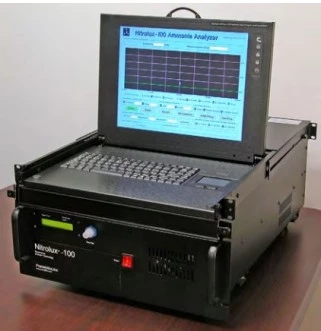Description
**Nitrolux®-100: Precision Ammonia Detection at Its Best** The Nitrolux®-100 stands as the pinnacle of Pranalytica's Nitrolux® sensor family, offering unparalleled sensitivity for ambient level atmospheric ammonia detection. With a guaranteed sensitivity of 100 parts-per-trillion (ppt), this flagship sensor ensures the highest level of accuracy in ammonia measurement. Its advanced technology eliminates interference from trace gases, providing precise ammonia determination even in challenging environments. The Nitrolux®-100 is a trusted choice for semiconductor fab clean rooms, where maintaining sub-ppb levels of ammonia is crucial to prevent degradation of high-performance integrated circuits.
Pranalytica's commitment to excellence is evident in the extensive deployment of the Nitrolux®-100 across various industries. Its robust design and reliable performance make it an essential tool for quality assurance in semiconductor manufacturing. The sensor's ability to continuously monitor ammonia levels without the need for preconcentration or conversion streamlines the detection process, ensuring seamless operation and minimal maintenance. With a rapid measurement cycle and autonomous operation, the Nitrolux®-100 delivers real-time data that is critical for maintaining optimal environmental conditions.
Beyond semiconductor applications, the Nitrolux® family, including the Nitrolux®-200 and Nitrolux®-1000, plays a vital role in environmental monitoring. High levels of ambient ammonia pose significant health risks and contribute to PM2.5 formation. By providing accurate and reliable ammonia measurements, these sensors support environmental protection agencies in their efforts to safeguard public health. The Nitrolux®-100's precision and reliability make it an indispensable asset for any organization committed to maintaining high standards of environmental and industrial safety.
Ammonia Sensor
Specifications
| Type Of Compound: | Ammonia |
|---|---|
| Detection Technology: | Not Specified |
| Minimum Detectivity: | 100 ppt (parts per trillion) |
| Number Of Cells: | One |
| Measurement Time: | 36 seconds (optional 10 seconds) |
| Analyzer Operation: | Autonomous (no operator attention necessary) |
| Response Time: | 2 measurement cycles (0-90% change) |
| Selectivity: | No interference from other ammonium containing compounds, hydrocarbons, hydrogen sulfide, sulfur dioxide, hydrogen fluoride, hydrogen chloride, water and NOX |
| Linearity: | ±10% of full scale |
| Accuracy: | ±100 parts-per-trillion or ±10% of the reading (whichever is greater) |
| Precision: | ±100 parts-per-trillion or ±10% of the reading whichever is larger (relative accuracy) |
| Zero Drift: | ±100 parts-per-trillion per week (non-cumulative) |
| Span Drift: | ±10% of full scale per month (non-cumulative) |
| Control Processor: | Pentium class microcomputer embedded in the Nitrolux |
| Operating System: | LINUX based to assure high reliability |
| Data Storage: | Embedded in the Nitrolux, All completely solid state memory for crash-proof reliability, User data storage capacity for > 1 year (Option EDS provides over 4 years of continuous data storage capability) |
| Data Display: | Full color graphical display showing ammonia as a function of time and location (GPS option GP1) and provides the capability for programming alarms settings, etc |
| Data Output: | RS 232 serial data |
Features
- Ultra-Sensitive Detection: The Nitrolux®-100 offers a guaranteed sensitivity of 100 parts-per-trillion (ppt) for precise ammonia detection.
- Advanced Measurement Technology: Ensures accuracy by eliminating interference from trace gas interferents commonly found in the environment.
- Continuous Monitoring: Provides uninterrupted measurement cycles for real-time ammonia level monitoring.
- Quick Measurement Time: Standard measurement time is 36 seconds, with an optional rapid 10-second cycle available.
- Autonomous Operation: Designed to operate without the need for constant operator attention, ideal for busy environments.
- Fast Response Time: Achieves a 0-90% change in just two measurement cycles.
- High Selectivity: No interference from other ammonium compounds, hydrocarbons, hydrogen sulfide, sulfur dioxide, hydrogen fluoride, hydrogen chloride, water, and NOX.
- Reliable Linearity and Accuracy: Maintains ±10% of full scale linearity and ±100 ppt or ±10% accuracy (whichever is greater).
- Precision and Stability: Features a precision of ±100 ppt or ±10% of the reading, with minimal zero and span drift.
- Robust Control Processor: Equipped with a Pentium class microcomputer for efficient processing.
- Reliable Operating System: Utilizes a LINUX-based system to ensure high reliability and performance.
- Extensive Data Storage: Solid-state memory provides crash-proof reliability with over 1 year of user data storage capacity, expandable to over 4 years with Option EDS.
- Comprehensive Data Display: Full-color graphical display shows ammonia levels over time and location, with programmable alarm settings.
- Versatile Data Output: Equipped with RS 232 serial data output for seamless integration with other systems.
Applications
- Semiconductor Manufacturing: Extensively used in semiconductor fab clean rooms for quality assurance by measuring ambient ammonia at sub-ppb levels, which is crucial as PPB level ammonia can degrade the quality of high-performance integrated circuits.
- Environmental Monitoring: Deployed by environmental protection agencies for ambient ammonia monitoring. High levels of ambient ammonia are harmful to human health and are precursors for PM2.5 formation.
- Industrial Applications: Useful in various industrial settings where accurate detection of ammonia levels is critical to maintaining safety and product quality.
- Research and Development: Utilized in R&D settings where precise measurement of ammonia is required for experimental and analytical purposes.
- Quality Control: Employed in quality control processes across different industries to ensure that ammonia levels are within acceptable limits, thereby protecting product integrity and safety.
Frequently Asked Questions
What is Nitrolux®-100?
What are the applications of Nitrolux®-100?
What is the accuracy of Nitrolux®-100?
What is the response time of Nitrolux®-100?
What is the measurement cycle of Nitrolux®-100?
Similar Products
Your inquiry has been received.
Create an account by adding a password
Why create an account?
- Auto-complete inquiry forms
- View and manage all your past messages
- Save products to your favorites
- Close your account anytime — no hassle

